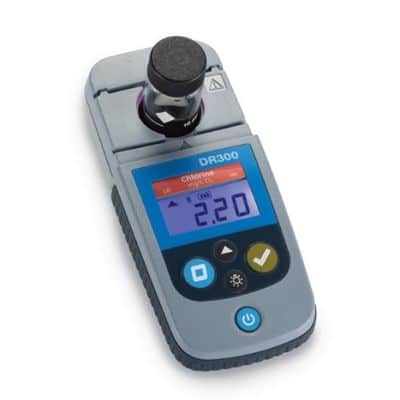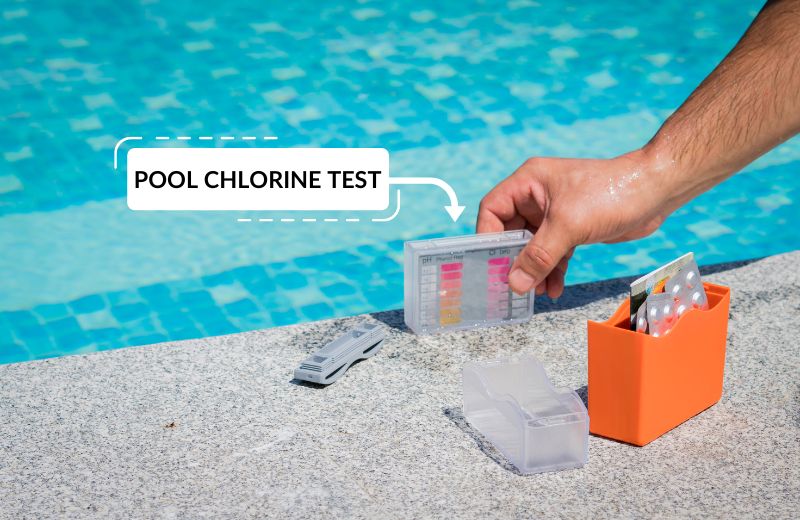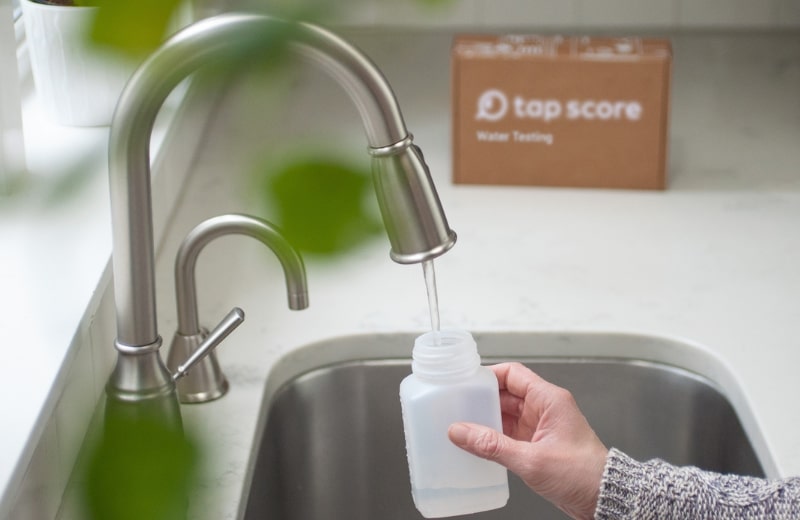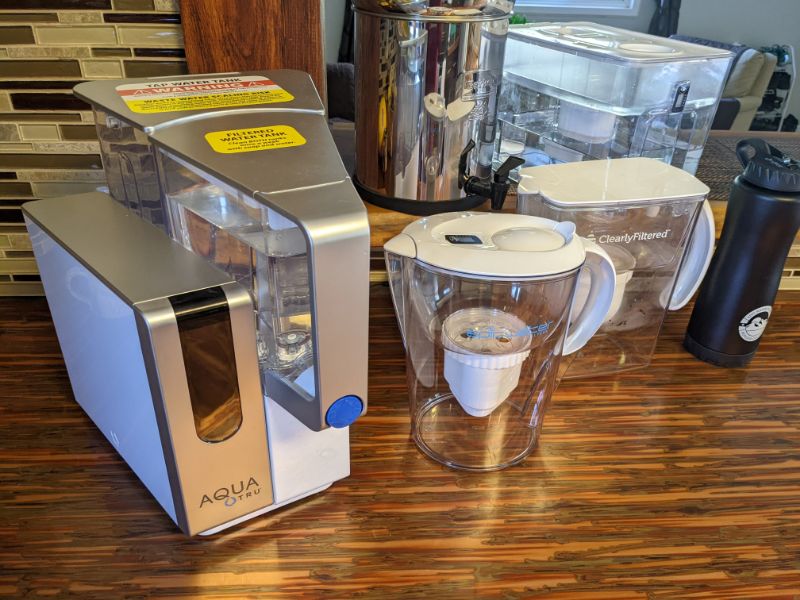Chlorine is the most commonly used chemical for the disinfection of public drinking water supplies in the US.
While the low levels of chlorine used for disinfection purposes are considered safe, you might want to remove chlorine from your water to eliminate the poor tastes associated with this chemical. Chlorine is also associated with toxic disinfection byproducts in drinking water.
Your first step is to find out how much chlorine is present in your water, and for that, you can use a chlorine water test.
Our water treatment experts have tried all the different methods of testing water for chlorine, and we’ve shared our top recommended techniques in this guide.

Table of Contents
🧪 Use Chlorine Test Strips
Chlorine test strips are an affordable, easy option for testing for free chlorine or total chlorine in your home’s drinking water source.
These test kits deliver instant results – you can get a chlorine reading of your water sample without having to send it off to a lab.
The type of chlorine detected varies from test to test. Most chlorine tests detect both free chlorine/free residual chlorine and combined chlorine. Some may only test for total chlorine: a combination of free chlorine and combined chlorine.
Grouped contaminant test strips are the most popular DIY testing option. They don’t only detect chlorine present in drinking water – they also detect lead, iron, pH, hardness, zinc, fluoride, and other common tap water contaminants.
To use chlorine test strips to test your tap water, follow these steps:
- Prepare a sample of cold water from your faucet.
- Take a strip from your test kit and dip it into the sample.
- Keep the strip submerged according to the test instructions, then remove it from the water.
- Observe the squares on the test strip, which should have now changed color.
- Compare the colors of the squares to the included color chart to get a reading of the chlorine concentration in your water.
Using test strips is the best option if you don’t have a big budget and you just want an idea of how much chlorine your water contains. You can buy a test with around 50-120 strips for less than $20.

📇 Use A Digital Colorimeter
One of the more accurate chlorine testing methods that you can conduct yourself at home, producing instant results, is a digital colorimeter.
The most common method used by digital colorimeters is the diethyl-p-phenylenediamine (DPD) method. In this method, a DPD reagent is added to the sample water. This causes the change of color to pin, indicating the presence of chlorine.
Most digital colorimeters can detect free chlorine or total chlorine (both free chlorine and combined chlorine) in water, typically ranging from 0.00 to 3.50 PPM.
To use a digital colorimeter to detect chlorine in water, follow these steps:
- Fill a clean container with a sample of your tap water.
- Follow the instructions to calibrate the initialize the colorimeter (if needed).
- If your colorimeter uses DPD tablets or powder, add the appropriate amount to the water sample.
- Wait for the reagent to react with chlorine, causing the water to change color.
- Insert the water sample into the colorimeter.
- Read the chlorine measurement on the digital display screen.
A digital colorimeter for chlorine costs around $65-$85. It’s more expensive than chlorine test strips, but cheaper than lab testing in the long term given that you can use the device as many times as you want, without having to pay for separate testing each time.

🎴 Use A Pool Test Kit
There are a few different methods of chlorine testing for pool water.
One option is to use test strips. Swimming pools contain more chlorine than drinking water, so dedicated swimming pool chlorine test strips may test for higher concentrations of chlorine than test strips for tap water.
Other pool test kits use a liquid chemical called Orthotolidine to detect total chlorine levels. In the presence of chlorine, orthotolidine undergoes a chemical reaction. The chlorine oxidizes orthotolidine to form a yellow-brown or reddish-brown color.
To use a pool test kit with orthotolidine to measure chlorine, follow these steps:
- Use a clean container to collect a water sample from your pool.
- Follow the instructions provided with your orthotolidine testing kit to add a suitable amount of orthotolidine reagent to the water sample.
- Stir or shake the water sample to mix it properly with the reagent.
- Wait for the color change to occur. The intensity of the color will indicate the concentration of chlorine in the pool water.
- Compare the color of the water sample to a provided color chart, which will indicate the chlorine concentration in the water.
Keep in mind that this technique doesn’t measure free chlorine concentration, but only the presence of total chlorine.

🤔 Do Laboratories Offer Chlorine Testing?
If test strips and other at-home testing methods don’t produce the precise results you’re looking for, we often recommend using a certified laboratory water test.
But even though laboratories do offer chlorine tests, they don’t actually test for chlorine in the lab itself.
Instead, the lab will send chlorine test strip kits to you, so you can test chlorine in your water at home.
Why don’t labs do a reading of your water’s chlorine levels in-house?
Chlorine is highly volatile and dissipates quickly once it comes into contact with air. By the time your water sample made it to the lab, most of the chlorine would likely have dissipated, meaning that the lab wouldn’t get an accurate or exact reading of chlorine in your water.
You might choose to use certified laboratory testing if you want to get your water professionally tested for other common contaminants as well as chlorine.
For instance, our recommended water testing lab, Tap Score by SimpleLab, sells an Essential City Water Test. For this test, Tap Score sends customers test strips for detecting both chlorine and chloramine at home, as well as performing laboratory screening for common city water contaminants, like lead, fluoride, hardness, copper, and nitrate.

📝 Interpreting Your Results
Once you’ve got a chlorine reading for your drinking water, you can decide what you want to do with your results.
This could involve looking into a water treatment system that can remove chlorine, which you may want to do if your water has a poor taste or smell caused by the chlorine present.
There are several methods of removing free chlorine or residual chlorine from your drinking water, including:
- Activated carbon water filters, which use a process called adsorption to trap chlorine and other contaminants across their media. These can be used in whole-home filter systems, as well as countertop filters, water pitcher filters, and water bottle filters.
- Reverse osmosis systems, which feature a semi-permeable membrane made of tiny pores that block even the smallest contaminants from passing through. These are installed underneath a kitchen sink or on a countertop. Whole-home reverse osmosis filters are also available.
- Water distillers, which remove chlorine by boiling and evaporation.
- Boiling your water, which speeds up the rate of chlorine dissipation.

If you already own a water filter, you can also use chlorine test kits to check that your water filter is removing chlorine properly.
You might also want to conduct further testing for disinfection byproducts, which are formed when chlorine reacts with organic materials in water – one of the biggest side effects of the chlorination of water.
📑 Final Word
We made this guide as a reference for folks looking for easy ways to test for chlorine in drinking water and pool water.
To summarize, we recommend using a DIY chlorine test kit with testing strips if you want a quick, instant method of detecting chlorine in water at home. You could pay for a digital colorimeter if you want to routinely test your water for chlorine without having to pay for new tests each time.

How do you test for seriously too much chlorine?
You can buy simple chlorine test strips on Amazon or your local hardware store!